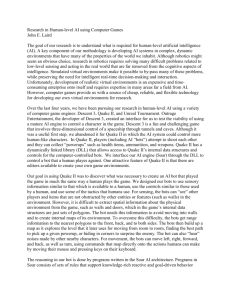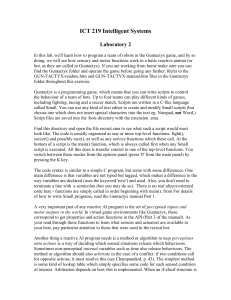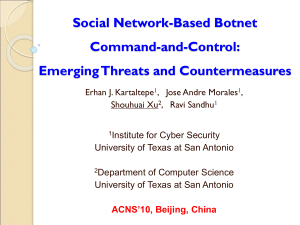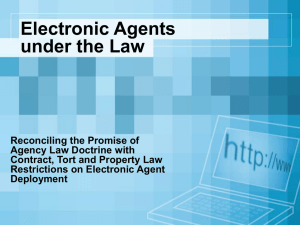Related Robots
advertisement
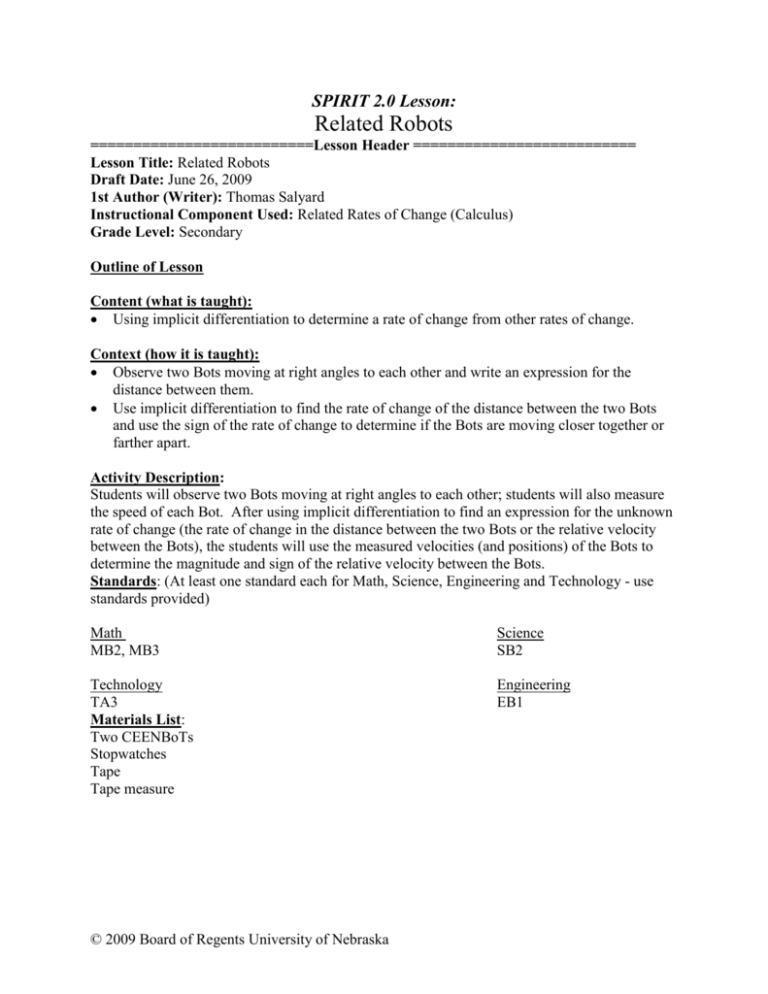
SPIRIT 2.0 Lesson: Related Robots ==========================Lesson Header ========================== Lesson Title: Related Robots Draft Date: June 26, 2009 1st Author (Writer): Thomas Salyard Instructional Component Used: Related Rates of Change (Calculus) Grade Level: Secondary Outline of Lesson Content (what is taught): Using implicit differentiation to determine a rate of change from other rates of change. Context (how it is taught): Observe two Bots moving at right angles to each other and write an expression for the distance between them. Use implicit differentiation to find the rate of change of the distance between the two Bots and use the sign of the rate of change to determine if the Bots are moving closer together or farther apart. Activity Description: Students will observe two Bots moving at right angles to each other; students will also measure the speed of each Bot. After using implicit differentiation to find an expression for the unknown rate of change (the rate of change in the distance between the two Bots or the relative velocity between the Bots), the students will use the measured velocities (and positions) of the Bots to determine the magnitude and sign of the relative velocity between the Bots. Standards: (At least one standard each for Math, Science, Engineering and Technology - use standards provided) Math MB2, MB3 Science SB2 Technology TA3 Materials List: Two CEENBoTs Stopwatches Tape Tape measure Engineering EB1 © 2009 Board of Regents University of Nebraska Asking Questions (Related Robots) Summary: Students will examine two Bots moving relative to an “intersection” marked on the floor. (A sketch will also appear on the board.) Students will be asked to conjecture if the Bots are getting closer together or farther apart at a given moment in time based on visual observations. Outline: 1) Students will examine two Bots moving relative to an “intersection” marked on the floor. (A sketch will also appear on the board). Students will be asked to conjecture if the Bots are getting closer together or farther apart at a given moment in time based on visual observations. Activity: Students will observe the Bots moving relative to the intersection and decide if the Bots are moving closer together or farther apart based on visual inspection. Questions Are the speeds of the Bots the same? Relative to the intersection, are the velocities positive or negative? Based on the sketch of the situation, can you give symbols to represent each velocity? What symbol would represent the relative velocity between the two Bots (the relative rate of change of the distance between the two)? © 2009 Board of Regents University of Nebraska Answers They should be different if one Bot is in analog mode and the other not. One will be negative (the Bot moving down the page) and the other positive. The symbols are dx/dt and dy/dt. The symbol is dz/dt. Exploring Concepts (Related Robots) Summary: Students will measure the velocity of each vehicle by measuring how long it takes the Bot to travel a certain distance. Outline: 1) Provide each group with a Bot, tape measure and stopwatch. 2) Have students measure the speed of the Bot in standard and analog modes. 3) Allow students to consider how or if the different velocities might affect whether or not the relative distance between the Bots is increasing or decreasing at a given moment. Activity: Here the students are simply going to measure the speed of the Bot in digital and analog modes using the standard relationship v = s/t. (change in distance divided by change in time) © 2009 Board of Regents University of Nebraska Instructing Concepts (Related Robots) Related Rates Putting “Related Rates” in Recognizable terms: Related rates problems are a common topic in calculus. They are concerned with finding an unknown rate of change in terms of known rates of change. The rate of change is usually with respect to time. The process of applying related rates of change allows you to find how quantities are changing at a given time or how the relationship between quantities is changing. Putting “Related Rates” in Conceptual terms: Related rates problems show the relationship between unknown and known rates of change. These problems apply when you have two objects moving relative to one another or the same point, or when one object has something that is changing over time. You will use the current measured quantities and rates to find out how fast the change is occurring at a different time. Putting “Related Rates” in Mathematical terms: The process of using related rates to find an unknown rate given a known rate is standard in all problems. 1. Find a formula that relates the original quantities in the problem. This formula often, but not always, comes from geometry. 2. Implicitly differentiate the formula with respect to time. 3. Solve for the unknown rate It will look something like dx/dt. 4. Substitute in the original quantities and known rates and simplify to find the unknown rate. Putting “Related Rates” in Process terms: Thus by finding the rate at which something is changing will allow the user to make decisions about how to react. This process is adaptable to science, navigation, business, manufacturing, and engineering. It provides mathematical proof about how the situation is changing at any point in time. In addition, it can tell how the change that is occurring differs over time. Putting “Related Rates” in Applicable terms: Related Rates can apply anywhere that you need to find an unknown rate. Related rates can be applied in many different situations. For instance the process can find how airplanes are changing relative to one another or the control tower, how fast water is filling or draining from a container, or a ladder is moving when it slips. Basically, any situation where there is a change in position over time the process of related rates could apply. © 2009 Board of Regents University of Nebraska Organizing Learning (Related Robots) Summary: Students will use the Pythagorean Theorem to relate the variables x, y and z. Since x, y and z are ultimately functions of time; the equation can be differentiated using implicit differentiation (with respect to time). Since x, y, z and dx/dt and dy/dt are all given or measured, the unknown rate of change (dz/dt) can be determined. Outline: 1) Students will relate x, y and z using the Pythagorean Theorem. 2) Students will (possibly with direction) recognize that the equation can be differentiated with respect to time. 3) Students will solve for the unknown rate of change (dz/dt) symbolically and then numerically using values for all other quantities, which are either measured or given. Activity: Each group of students will be asked to use the sketch and find a formula relating the relative position of each Bot relative to the intersection and the relative position of the Bots (represented by x, y and z, respectively). Eventually, each group should realize that the variables are the sides of a right triangle, with z as the hypotenuse. Thus, the relationship is x2 + y2 = z2. At this point, the students will need to use implicit differentiation to find the derivatives of each term with respect to time. This new equation can be solved for the relative velocity between the two Bots (dz/dt) in terms of x, y and z and dx/dt and dy/dt. Finally, the measured values of dx/dt, dy/dt and given values of x and y can be used to determine the magnitude of the relative velocity; if values for x and y are chosen carefully, it is possible that the relative velocity will be negative, meaning that the Bots are actually getting closer together. © 2009 Board of Regents University of Nebraska Understanding Learning (Related Robots) Summary: Once students demonstrate understanding of this particular problem, they will be asked to apply the same technique to additional problems; some based on the Pythagorean Theorem and some which are not. Outline: 1) Formative assessment of identifying quantities and rates, differentiating the Pythagorean formula correctly and properly interpreting the quantity dz/dt. 2) Summative assessment of constructing a formula relating several quantities, differentiating the formula and solving it for one rate of change in terms of other rates of change. Activity: Formative Assessment As students are engaged in the lesson ask these or similar questions: 1) Were the students able to identify the derivatives of x and y as the velocities of the vehicles? 2) Were the students able to relate x, y and z using the Pythagorean Theorem? 3) Were students able to find the derivative of the equation correctly? 4) Were the students able to solve for the unknown rate, dz/dt, in terms of the quantities x, y, z, dx/dt and dy/dt? 5) Were students able to use the sign of dz/dt to determine whether the vehicles were getting closer together of farther apart? Summative Assessment At the end of the lesson, the students would have the following as practice/homework: (1) One or more problems about two cars at an intersection with different values for all quantities. (2) One or more problems based upon the Pythagorean Theorem (a sliding ladder against a wall, a kite moving horizontally away from the owner, a boat being winched toward a dock). (3) One or more problems, which are based on other geometric formulas (for example, the relationship between the rates of change in the radius and volume of a spherical balloon in which air is being added). Sample Problems: 1) An air traffic controller spots two planes at the same altitude converging on a point as they fly at right angles to one another. One plane is 150 miles from the point and is moving at 450 mph. The other plane is 200 miles from the point and has a speed of 600 mph. How fast is the distance between the planes changing? 2) A boat is pulled in by means of a winch on the dock 12 feet above the deck of the boat. The winch pulls in a rope at the rate of 4 ft/sec. Determine the speed of the boat when there are 13 feet of rope out. What happens to the speed of the boat as it gets closer to the dock? 3) A ladder 25 feet long is leaning against a house. The base of the ladder is pulled away from the house wall as a rate of 2 ft/sec. How fast is the top of the ladder moving down the wall when the base of the ladder is 15 ft. from the wall? 4) Air is being pumped into a spherical balloon at a rate of 4.5 in3/min. Find the rate of change of the radius when the radius is 2 inches. © 2009 Board of Regents University of Nebraska


